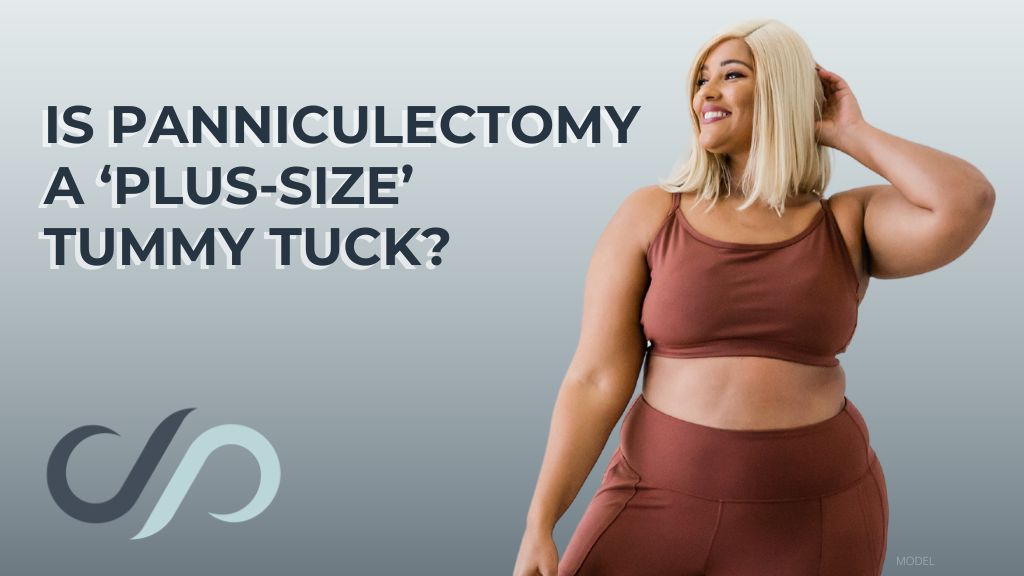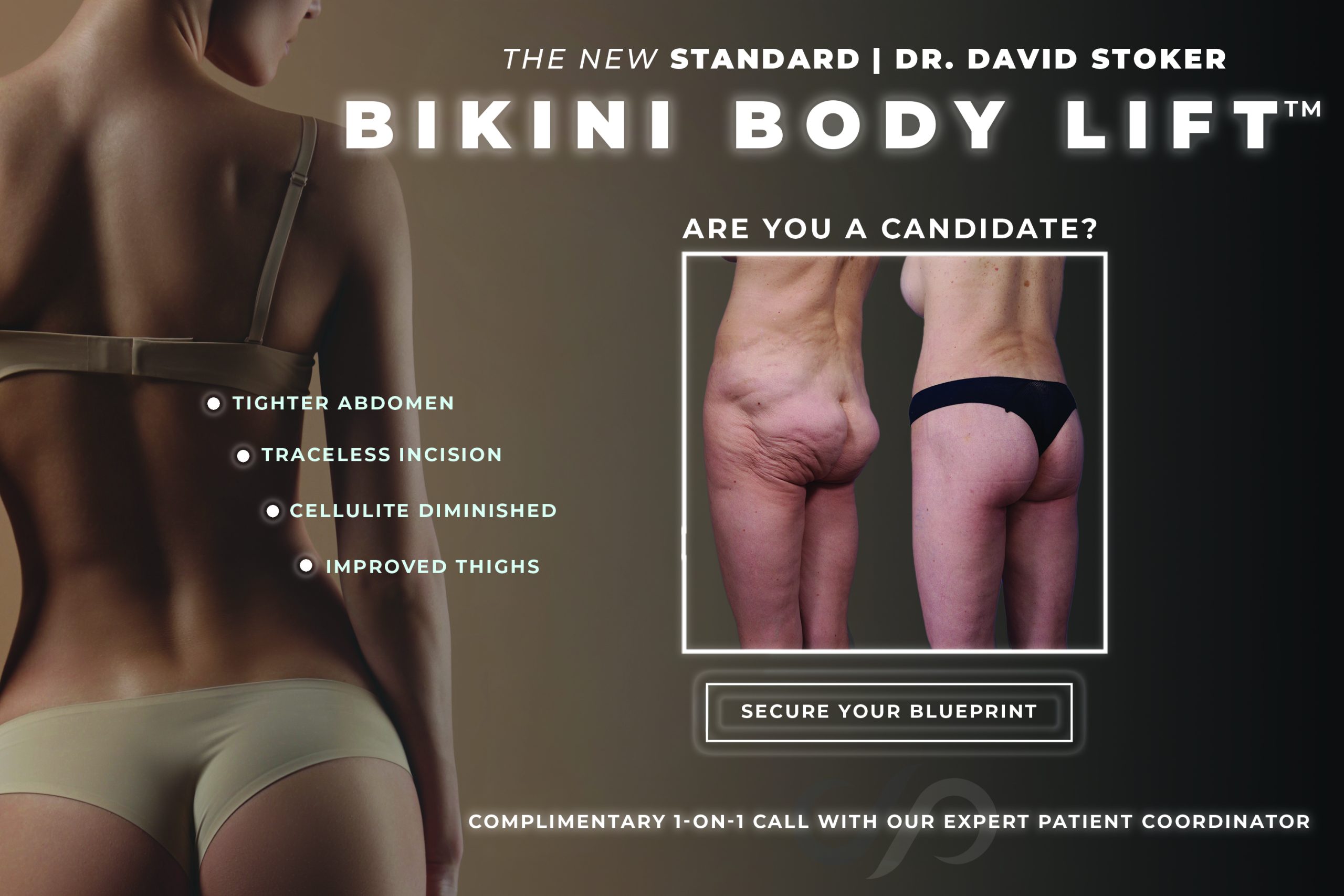Losing significant weight is a remarkable accomplishment, whether you’ve made lifestyle changes, undergone bariatric surgery, or achieved success with GLP-1 medications such as Ozempic®. Putting the final touches on your physical transformation may include body contouring surgery to remove excess skin, such as a tummy tuck. In this blog post, I discuss the ‘plus size’ tummy tuck and how it compares to a panniculectomy.
Panniculectomy vs. Tummy Tuck
The panniculus is the apron of excess abdominal skin that hangs over the waist after weight loss, and surgery is really the only solution for people who feel self-conscious about their appearance. That procedure is called a panniculectomy. In a panniculectomy, I remove hanging skin and fat from the lower abdomen.
I do not undermine the remaining skin as I would in the typical abdominoplasty (tummy tuck) or tighten the muscles. I instead bring the edges of fat and skin together with a layered closure. The advantage of not undermining is that the procedure is smaller, and potential problems are fewer. The disadvantage is that there’s minimal improvement to the central and upper abdomen.
The primary distinction between the two procedures lies in their goals. During a tummy tuck, I tighten the abdominal muscles and remove excess fat, skin, and tissue. I often combine it with liposuction to enhance the aesthetic outcome.
A panniculectomy, meanwhile, is specifically designed to remove the panniculus. In certain cases, I may recommend combining a tummy tuck with a panniculectomy. This is most common for patients who have had children and need to address a condition called diastasis recti, which is the separation of abdominal muscles during pregnancy that requires repair.
| Panniculectomy | Tummy Tuck | |
|---|---|---|
| Purpose | Removes the panniculus – the overhanging skin – from the lower abdomen. | Focuses on removing excess skin and fat from the abdomen while tightening the abdominal muscles for a more toned appearance. |
| Recovery Time | Panniculectomy has a shorter recovery time because it primarily involves removing excess skin without muscle tightening. | Requires a longer recovery period due to the extent of the surgery and the involvement of muscle tightening. |
| Aesthetic Outcome | It does not offer the same degree of abdominal contouring or waistline refinement as a tummy tuck, but it does create a smoother silhouette. | This leads to a flatter and more sculpted abdomen and an improved waistline. Often combined with liposuction to enhance the results. |
| Incision Length | Requires shorter incisions limited to the lower abdomen to remove the panniculus, resulting in reduced scarring. | The incision extends from hip to hip. A longer incision may be needed if the procedure includes removing excess skin and fat from the flanks and lower back (extended tummy tuck). |
| Surgical Risks | Because it removes skin and fat without manipulating muscles, it has fewer surgical risks than a tummy tuck. | Muscle tightening may carry additional risks, including postoperative discomfort and longer recovery. |
| Coverage | Often performed for medical reasons to relieve symptoms caused by excess skin. Insurance may cover it. | It’s considered a cosmetic procedure that is not covered by insurance. |
Surgery After Weight Loss Before and After Photos
Which Procedure Is Best for You?
The apron of skin that hangs below the waist isn’t just an aesthetic issue. It can also cause various health issues, such as back problems, skin rashes, ulcers, or other skin disorders. Additionally, it can interfere with everyday tasks such as walking, sitting, standing, or driving.
A tummy tuck is the more extensive procedure of the 2 because it goes beyond removing the skin. At my Los Angeles practice, women and men who have lost significant weight and want plastic surgery for excess skin removal may have multiple procedures to address other areas of the body. This previous blog post provides more information about body contouring surgery after weight loss.
If you’re wondering whether to get a panniculectomy or a tummy tuck, consider these key points:
- A panniculectomy can give you a flatter abdomen, more mobility, and relief from rashes and skin irritations.
- However, it can’t tighten your abdominal muscles and give you the flat tummy that abdominoplasty (tummy tuck) can. If you want a taut and trim midsection, a tummy tuck is probably your best bet.
- A panniculectomy strictly removes hanging skin from the lower abdomen; it doesn’t touch the area above the bellybutton. Most people who have a panniculus also have large upper stomach folds, and they would much rather have all the skin re-draped, which is what a tummy tuck does. A panniculectomy addresses only the lower folds—it leaves all the upper folds of loose skin there.
- A tummy tuck can also reposition the bellybutton and may involve liposuction to fully contour the flanks and even the back.
Patients often decide to combine the procedures to reap the benefits of a tummy tuck, such as core strength and improved midsection appearance.
Your overall health is also a factor when deciding whether to get a tummy tuck or panniculectomy. Because a tummy tuck is a more extensive procedure, patients who may not be healthy enough to undergo it may still benefit from a panniculectomy.
Start Your Body Contouring Journey
By losing a significant amount of weight, you’ve made a life-changing accomplishment that can lead to a healthier life. To fully appreciate this accomplishment, many women and men decide to undergo plastic surgery to remove excess skin.
As one of the top tummy tuck surgeons and body contouring specialists, I see patients from throughout the US and internationally. You can request a consultation with me using the online form or call Stoker Plastic Surgery at (310) 361-3438 to schedule an appointment.
















Leave a Reply